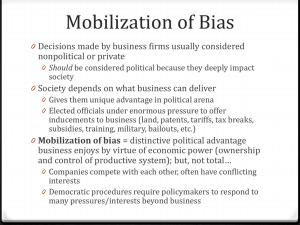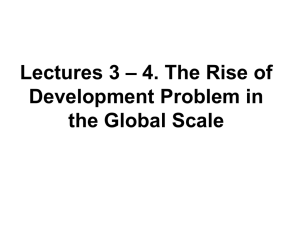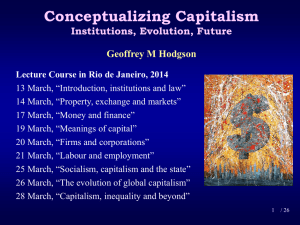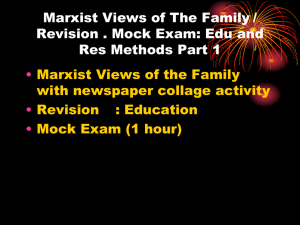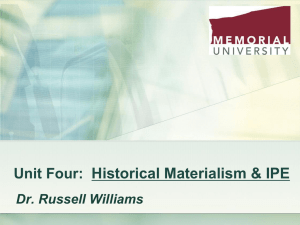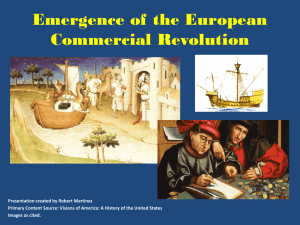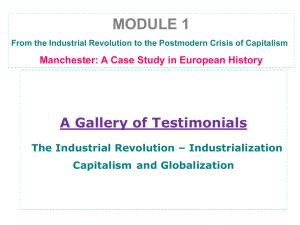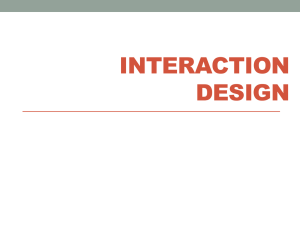Conceptualizing Capitalism
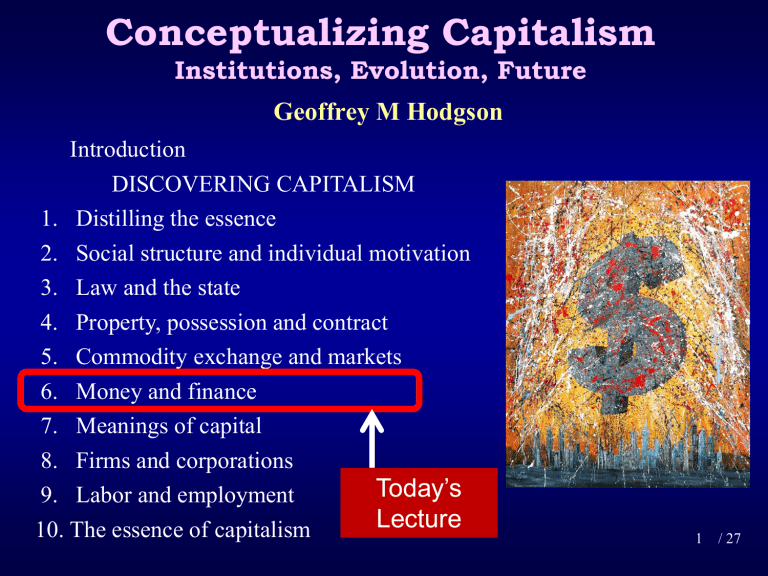
Conceptualizing Capitalism
Institutions, Evolution, Future
Geoffrey M Hodgson
Introduction
DISCOVERING CAPITALISM
1. Distilling the essence
2. Social structure and individual motivation
3. Law and the state
4. Property, possession and contract
5. Commodity exchange and markets
6. Money and finance
7. Meanings of capital
8. Firms and corporations
9. Labor and employment
10. The essence of capitalism
Today’s
Lecture
1 / 27
Conceptualizing Capitalism
Institutions, Evolution, Future
Geoffrey M Hodgson
ASSESSING CAPITALISM
11. Conceptualizing production
12. Socialism, capitalism, and the state
13. How does capitalism evolve?
14. The future of global capitalism
15. Addressing inequality
16. Capitalism and beyond
17. Coda on legal institutionalism
2 / 27
Conceptualizing Capitalism
Lecture 3: Money and finance
Contents of this Lecture:
1. Money as a spontaneous order
2. A brief history of money
3. The evolution of finance
4. The ontology of money
5. Money and capitalism
3 / 27
Conceptualizing Capitalism
Lecture 3: Money and finance
Money as a spontaneous order.
Carl Menger (1871):
“As each economizing individual becomes increasingly more aware of his economic interest, he is led by this interest, without any agreement, without legislative compulsion , and even without regard to the public interest , to give his commodities in exchange for other, more saleable, commodities, even if he does not need them for any immediate consumption purpose .”
“… we can everywhere observe the phenomenon of … goods, especially those that are most easily saleable at a given time and place, becoming, under the influence of custom , acceptable to everyone in trade, and thus capable of being given in exchange for any other commodity.
”
4 / 27
Conceptualizing Capitalism
Lecture 3: Money and finance
Money as a spontaneous order.
Carl Menger (1883) accepted that “history actually offers us examples that certain wares have been declared money by law .”
But these declarations are “the acknowledgement of an item which had already become money .”
“the origin of money can truly be brought to our full understanding only by our learning to understand the social institution discussed here as the unintended result, as the unplanned outcome of specifically individual efforts of members of a society .”
5 / 27
Conceptualizing Capitalism
Lecture 3: Money and finance
Money as a spontaneous order.
Menger ’s account is heuristic – it is an attempt to identify the essential nature of money , not to describe its actual evolution.
Useful heuristic models are strictly unrealistic yet they can illuminate important aspects of reality
( Sugden 2000).
How do we appraise heuristics? Models?
Agent-based simulations of Menger ’s money
“thought experiment” are inconclusive ( Marimon ,
McGrattan & Sargent 1990)
6 / 27
Conceptualizing Capitalism
Lecture 3: Money and finance
Money as a spontaneous order.
“Testing” a heuristic, by adding realistic features.
Menger ’s account involves a coordination game, like language & some traffic rules.
In a coordination game equilibrium, “not only does no player have any incentive to change his behavior, given the behavior of other players, but no player wishes that any other player would change either”
( Schotter 1981).
Not all institutions derive from coordination games
( Vanberg 1994, Schultz 2001).
7 / 27
Conceptualizing Capitalism
Lecture 3: Money and finance
Money as a spontaneous order.
Menger (1892) originally assumed that everyone recognized the emerging monetary unit and accept its value, because precious metals are “easily controlled as to their quality and weight .”
Assumed away possibilities of debasement or forgery.
Quality variation to the money unit undermines the coordination game.
Menger (1909): “Only the state has the power to protect effectively the coins and other means of exchange which are circulated, against the issue of false coins, illegal reductions of weight and other violations that impede trade.”
8 / 27
Conceptualizing Capitalism
Lecture 3: Money and finance
Money as a spontaneous order.
Menger considered money as a medium of exchange
– but not as a unit of account.
Assume gold emerges as a medium of exchange.
A shared system of weights and measures would be necessary.
There must be some system of checking and enforcing these weights and measures, to avoid cheating.
It is difficult to see this as a coordination game.
Menger’s model of spontaneous emergence is vulnerable to slight improvements in its realisticness.
9 / 27
Conceptualizing Capitalism
Lecture 3: Money and finance
Money as a spontaneous order.
Menger ’s theory is weak as an explanation of origin.
Threats of forgery and debasement are there at the start, when the network benefits are small.
But Menger ’s account retains value as an incomplete explanation of persistence.
Money is sustained both by state legislation and mutual convenience.
Money is not simply a medium of exchange but a unit of account – the integrity and measure of that unit has to be sustained by political power.
10 / 27
Conceptualizing Capitalism
Lecture 3: Money and finance
A brief history of money
Trade (principally between tribes) dates back to at least
10,000 years ago.
Caroline Humphrey (1985): “No example of a barter economy, pure and simple, has ever been described, let alone the emergence from it of money; all available ethnography suggests that there never has been such a thing .”
Philip Grierson (1977 ): “social currency” such as wergild
(compensation) long preceded commercial currency.
11 / 27
Conceptualizing Capitalism
Lecture 3: Money and finance
A brief history of money – from Mesopotamia to China
Money of account emerged long before coins or any other media of exchange – clay accounting records from the temples and palaces of Mesopotamia as early as 3200 BC.
These institutions maintained systems of weight and measurement, and kept accounts of debt & interest owed.
Shang Dynasty in China circa 1380 BC – use of cowrie shells as money.
12 / 27
Conceptualizing Capitalism
Lecture 3: Money and finance
A brief history of money – the Middle East
Around 2200 BC, in Central Anatolia, the state supervised the purity and weight of silver ingots, thus enabling their use as money.
According to Herodotus, in the 7 th century BC the Lydians of Western Anatolia introduced gold and silver coins.
Mark Peacock (2006): “the state’s role in the development of coinage is undisputed … Coinage was not an endogenous development of the economic sphere … nor was it created merely in order to facilitate trade which had existed thousands of years before money”
State-minted coins were used to pay soldiers.
13 / 27
Conceptualizing Capitalism
Lecture 3: Money and finance
A brief history of money – from China to Stockholm
Chinese developed paper money from the 7 th century AD.
In the 8 th century, during the Tang Dynasty, Chinese merchants started using promissory notes or bills of exchange: feitsyan (flying money)
In the 9 th century, feitsyan was placed under state control.
In the 10 th century, the Song Dynasty, short of copper for its coins, issued the first generally circulating notes.
In 1661 banknotes were first issued in Europe by the
Stockholms Banco, a predecessor of the Bank of Sweden.
14 / 27
Conceptualizing Capitalism
Lecture 3: Money and finance
The evolution of capitalist finance – Italy
The real world is never in a general equilibrium where all contracts are completed – a monetary economy necessarily implies debt.
12 th century – public debt first appeared in Venice.
14 th century – banks and negotiable instruments used in
Venice, Florence etc.. Originally banks kept 100% reserve.
Wars from 1521-1544 in Italy plus growing Ottoman Empire
– which by 1566 held most of the eastern and southern
Mediterranean coastlines – devastated Italian commerce.
15 / 27
Conceptualizing Capitalism
Lecture 3: Money and finance
The evolution of capitalist finance – the Netherlands
In 17 th century the Netherlands developed sophisticated public and private finances.
Founded in 1609, the Bank of Amsterdam maintained roughly a 100 per cent reserve ratio on loans.
Dutch developed innovative institutional devices, e.g. public bonds, and shares in publicly traded companies such as the
Dutch East India Company.
The Amsterdam stock exchange facilitated investment.
Political crises led to collapse of the Dutch Republic in 1795.
16 / 27
Conceptualizing Capitalism
Lecture 3: Money and finance
The evolution of capitalist finance – England
1688 – Glorious Revolution or Dutch invasion?
Stephen R. Epstein (2000): post-1688 constitutional restrictions on the monarch were less significant than
England’s “belated catch up” with Continental Europe’s most developed financial systems: “the result of the country’s financial revolution rather than a revolution in political freedom and rights .”
Bank of England formed in 1694. After 1698 stock price quotes were regularly published in London.
A financial revolution prompted by wars: 1688-97 & 1701-13.
17 / 27
Conceptualizing Capitalism
Lecture 3: Money and finance
The evolution of capitalist finance – England
Geoffrey Ingham (2008): “the capitalist monetary system developed from the integration of private networks of mercantile trade credit-money with public currency – that is, state money.”
Saleable or “negotiable” debt was crucial – as attempted in
China, France, Italy & the Netherlands.
Problem of legal enforceability of sales of promises .
In 1600s, commercial cases shifted from law merchant courts to common law courts ( Baker 1979, Berman 1983).
But “blundering attempts” ( Beutel 1938) to deal with negotiability led businessmen to press Parliament.
18 / 27
Conceptualizing Capitalism
Lecture 3: Money and finance
The evolution of capitalist finance – England
Henry Dunning MacLeod ( 1872): “If we were asked – Who made the discovery which has most deeply affected the fortunes of the human race?
We think, after full consideration, we might safely answer – The man who first discovered that a Debt is a Saleable Commodity .”
MacLeod (1858) coined the term “Gresham’s Law.”
Mitchell Innes (1914) saw him as originator of the state theory of money. Commons (1934) saw him as “the first lawyer-economist.” Marx : he views
“everything from the unutterably narrow standpoint of a bank clerk .”
19 / 27
Conceptualizing Capitalism
Lecture 3: Money and finance
The evolution of capitalist finance – England
In 1704 – reign of Queen Anne – Parliament passed “An Act for giving like Remedy upon Promissory Notes, as is now used upon Bills of Exchange, and for the better Payment of Inland Bills of Exchange.”
Further legislation, including an Act of 1758, was required to consolidate negotiability ( Beutel 1938, Lawrence 2002).
Modern monetary systems require state authority and a state lender of last resort … also money is debt and it can be created by private banks.
20 / 27
Conceptualizing Capitalism
Lecture 3: Money and finance
The ontology of money - Marx
Marx (1859): “the commodity is the origin of money. … we are only concerned with those forms of money which arise directly from the exchange of commodities, but not with forms of money, such as credit money, which belong to a higher stage of production. For the sake of simplicity gold is assumed throughout to be the money commodity.
”
Marx (1867): a commodity is an “external object, a thing,” or a “physical body.”
21 / 27
Conceptualizing Capitalism
Lecture 3: Money and finance
The ontology of money - Marx
Marx , second volume of Capital: “credit money played no role, or at least not a significant one, in the early period of capitalist production.”
Marx , second volume of Capital, ch.
25 on “Credit and Fictitious Capital” opens:
“It lies outside the scope … to give detailed analysis of the credit system ... we shall simply be dealing with commercial and bank credit. The connection between … this and the development of state credit remains outside our discussion .”
22 / 27
Conceptualizing Capitalism
Lecture 3: Money and finance
The ontology of money
Problem : mechanical, substance-based, and agent-object ontologies of the economy.
This problem has pervaded economics from Smith to Samuelson . An exception:
Thorstein Veblen (1908): capitalized wealth consisted of “negotiable securities” based on tangible and intangible assets. These “become a basis of credit extensions, serving to increase the aggregate claims of creditors beyond what the hypothecable material wealth of the debtors would satisfy.” He noted “failure of classical theory to give an intelligent account of credit and crises.”
23 / 27
Conceptualizing Capitalism
Lecture 3: Money and finance
The ontology of money
John Searle’s (1995) ontology of institutions:
“But the truly radical break with other forms of life comes when humans, through collective intentionality, impose functions on phenomena where the function cannot be achieved solely in virtue of physics and chemistry but requires continued human cooperation in the specific forms of recognition, acceptance, and acknowledgement of a new status to which a function is assigned. This is the beginning point of all institutional forms of human culture, and must always have the structure
X counts as Y in C ...”
24 / 27
Conceptualizing Capitalism
Lecture 3: Money and finance
Money and Capitalism
Joseph A. Schumpeter
(1954):
“Owing to the importance of the financial complement of capitalist production and trade, the development of the law and the practice of negotiable paper and of ‘created’ deposits afford perhaps the best indication we have for dating the rise of capitalism .”
But
Schumpeter
dated this to the 16 th century.
25 / 27
Conceptualizing Capitalism
Lecture 3: Money and finance
Fractional-reserve banking has cumulative effect – it expands the money supply beyond the scale of the deposits alone.
Capitalist financial systems are vulnerable to destabilizers – inflation or spiraling debt.
John Maynard Keynes 1936: investment depends on expectations of the future, which are inherently uncertain and prone to disturbing perceptions or rumors.
Hyman Minsky (1982, 1986): capitalist finance is inherently unstable.
26 / 27
Conceptualizing Capitalism
1929 2008 27 / 27
